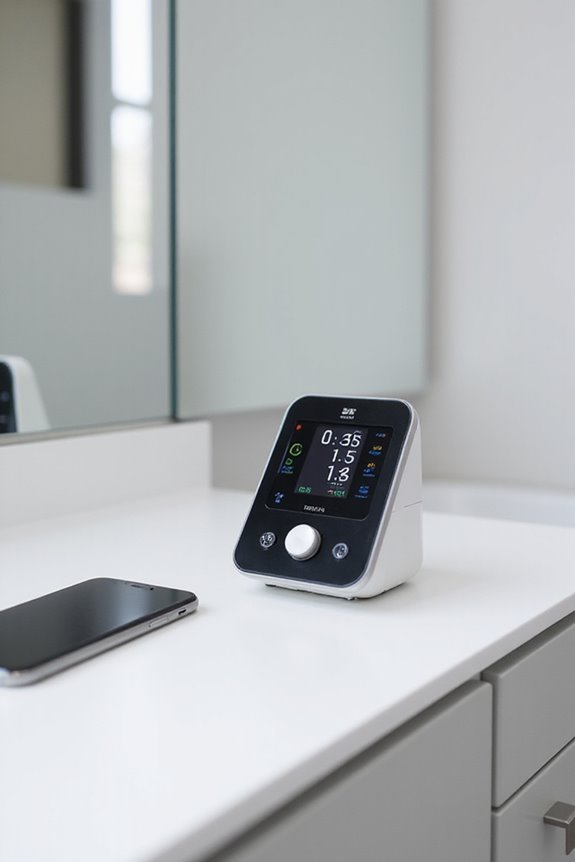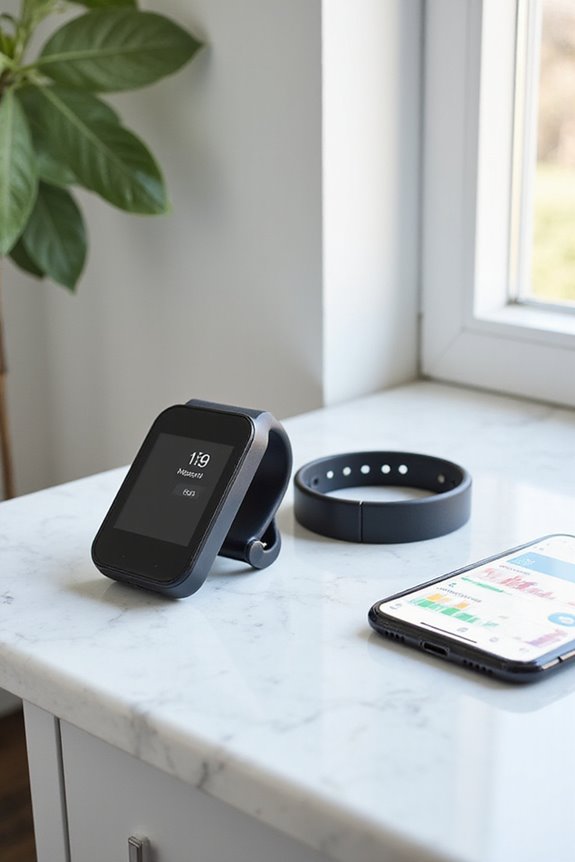Latest trends in smart blood pressure monitors include substantial market growth, projected to reach USD 4.68 billion by 2034 with a CAGR of approximately 9%. Technological innovations such as cuffless monitoring and AI integration enhance diagnostic accuracy. User-friendly interfaces and ergonomic designs improve accessibility. Connectivity features like Bluetooth and Wi-Fi allow seamless data management. Wearable devices increasingly support continuous monitoring, emphasizing personalized health strategies. Further insights into these developments reveal additional advancements in the field.
Key Takeaways
- The market for smart blood pressure monitors is projected to grow significantly, reaching USD 4.68 billion by 2034, driven by rising hypertension prevalence.
- Innovations like cuffless monitoring using ultrasonic technology are enhancing user convenience and comfort in blood pressure tracking.
- AI integration in devices provides real-time data analysis and personalized health insights, improving diagnostic accuracy for healthcare providers.
- User-friendly designs and compact wearables, such as smart rings, make health monitoring more accessible and appealing to a broader audience.
- Enhanced connectivity features, including Bluetooth and Wi-Fi syncing, allow for seamless data management and sharing with healthcare professionals.
Market Growth and Projections
The blood pressure monitoring devices market is poised for significant growth in the coming years. Valued at approximately USD 2.27 billion to USD 3.19 billion in 2025, projections indicate it may reach USD 4.68 billion by 2034, showcasing a compound annual growth rate (CAGR) of 8.49% to 9.1%.
Key market dynamics influencing this growth include:
- Increasing prevalence of hypertension.
- Rising healthcare expenditure, particularly in North America.
- Growing consumer awareness and demand for preventive healthcare.
Consumer behavior is shifting towards home monitoring solutions, driven by factors such as convenience, affordability, and telehealth services. The integration of mobile applications further facilitates adherence, enhancing market accessibility and engagement across diverse demographics. Additionally, the rise of clinically validated monitors ensures that consumers prioritize accuracy in their health monitoring devices.
Technological Innovations in Blood Pressure Monitoring

Advancements in blood pressure monitoring technology are considerably transforming healthcare delivery.
- Cuffless Monitoring: Innovations, particularly in ultrasonic technology, enable the development of wearable devices like smartwatches and rings, which can accurately measure blood pressure without traditional cuffs.
- AI Integration: Artificial intelligence enhances electronic devices by analyzing long-term trends and providing predictive insights.
- Real-Time Data Analysis: Devices now offer immediate data monitoring and analysis, improving diagnostic accuracy.
- Cloud-Based Storage: Health data is increasingly stored on cloud platforms, facilitating easy access for users and healthcare professionals.
- Miniaturization: Ultrasonic technology allows for smaller, more portable monitors, maintaining accuracy comparable to conventional devices. Additionally, some models utilize USB charging options to enhance user convenience and reduce battery maintenance.
These technological innovations collectively aim to elevate the standard of blood pressure monitoring globally.
Enhancements in User Experience and Design

Enhancements in user experience and design are essential for the adoption of smart blood pressure monitors. Key advancements include:
- User Friendly Interfaces: Modern monitors feature intuitive controls that simplify operation, catering to users of all ages.
- Ergonomic Designs: Devices like the Omron Evolv provide all-in-one, tubeless designs that enhance portability and comfort.
- Cuffless Monitoring Options: Innovations such as Novosound’s Slanj promote ease of use by eliminating traditional cuffs, improving user experience.
- Compact Wearables: Smart rings and wearables are gaining traction, appealing to those who prefer discreet health tracking.
- Aesthetic Appeal: Sleek designs resonate with users, merging functionality with modern aesthetics.
These enhancements guarantee that smart blood pressure monitors are accessible, comfortable, and aligned with user needs. Furthermore, the integration of Bluetooth connectivity allows for seamless data tracking and synchronization with smartphones, enhancing the overall user experience.
Connectivity Features and Data Management

Connectivity features and data management represent significant advancements in the functionality of smart blood pressure monitors.
- Bluetooth Integration: Most devices now utilize Bluetooth connectivity for automatic data synchronization with smartphone applications, streamlining user experience.
- Wi-Fi Sync: Some models offer Wi-Fi syncing, allowing for immediate data upload to cloud platforms, enabling real-time monitoring by healthcare providers.
- Data Storage: Devices typically store 50 to 99 past readings locally, while associated apps provide unlimited historical data storage for thorough tracking.
- Multi-User Functionality: Bluetooth-enabled devices support multiple users, ensuring individual data management without privacy concerns.
- Exporting Data: Users can export health data in standard formats like PDF and CSV for easy sharing with healthcare professionals.
- Enhanced Accuracy: Many smart monitors feature irregular heartbeat detection to alert users to potential arrhythmias, further improving overall health monitoring.
Advances in Wearable Technology

The evolution of wearable technology has introduced innovative solutions for blood pressure monitoring, considerably enhancing user convenience and accuracy.
Ultrasound Technology
- Miniaturized ultrasound sensors enable continuous, real-time blood pressure measurements, overcoming traditional cuff limitations.
- Novosound’s Slanj wearable exemplifies this with continuous wave ultrasound for precise arterial monitoring.
Miniaturization Innovations
- Smart rings and wearable patches provide discreet, multifunctional health tracking.
- These devices facilitate continuous blood pressure monitoring without the discomfort of cuffs.
AI Integration
- AI-driven analytics improve accuracy by interpreting sensor data and compensating for motion artifacts.
- Enhanced sensor fusion combines multiple biosensors, ensuring reliability in readings.
Such advancements in wearable sensors are pivotal in promoting better hypertension management and preventive healthcare, fostering a community focused on health and well-being. Moreover, the integration of Bluetooth connectivity into these devices allows for seamless data sharing and enhanced health management.
Future Developments in Smart Blood Pressure Devices
Recent innovations in wearable technology have laid the groundwork for the future of smart blood pressure devices, which are poised to revolutionize hypertension management.
Key developments include:
- Sensor Integration: Adoption of ultrasound-based and photoplethysmogram (PPG) sensors allows for real-time, cuffless monitoring, enhancing user comfort and accuracy.
- Calibration Improvements: Ongoing efforts are focused on enhancing accuracy in wrist-worn devices, addressing calibration challenges for greater clinical reliability.
- Data Connectivity: Enhanced Bluetooth and Wi-Fi integration guarantees seamless data transfer to healthcare platforms, fostering proactive management.
- Cloud Solutions: Cloud storage provides continuous access for users and healthcare providers, supporting telehealth initiatives.
These advancements signal a transformative shift towards more effective and user-friendly blood pressure monitoring solutions, aligning with the growing emphasis on personalized healthcare.
The Role of AI in Blood Pressure Monitoring
Artificial intelligence (AI) is increasingly becoming integral to blood pressure monitoring, enhancing both accuracy and the potential for early diagnosis.
- AI algorithms, such as Omron Healthcare’s Intellisense AFib, enable automatic arrhythmia detection during blood pressure measurements.
- Such early detection considerably reduces risks associated with undiagnosed atrial fibrillation, including stroke and heart failure.
Continuous monitoring is revolutionized by wearable sensors, predicting blood pressure trends with a low error margin.
– AI-enhanced devices provide non-invasive, cuffless readings, improving user comfort and convenience.
Moreover, AI’s role in personalized health is evident as it analyzes vast datasets to identify hypertension risk phenotypes, facilitating tailored management strategies. Proper cuff fit is essential for reliable readings, underscoring the importance of accurate monitoring in conjunction with AI advancements.
Frequently Asked Questions
How Do Smart Blood Pressure Monitors Differ From Traditional Monitors?
Smart blood pressure monitors distinguish themselves from traditional models through enhanced digital connectivity and intuitive user interfaces. These features foster greater engagement, allowing users to track health trends effortlessly, promoting a sense of belonging in their health management journey.
Are Smart Blood Pressure Monitors Suitable for All Age Groups?
The suitability of smart blood pressure monitors varies by age group, with middle-aged users showing greater compatibility. Older adults often face challenges adapting, highlighting the need for improved guidance and user-friendly designs to enhance overall engagement.
What Are the Battery Life Expectations for These Devices?
Battery life expectations vary greatly across devices, with smartwatches typically requiring more frequent charging due to their features, while dedicated monitors offer impressive battery longevity, allowing users to enjoy prolonged use without constant recharging concerns.
Can Smart Blood Pressure Monitors Be Used During Exercise?
Smart blood pressure monitors are not designed for exercise monitoring. Elevated heart rates during physical activity can lead to inaccurate readings, making it essential to measure blood pressure in resting conditions for reliable health assessments.
How Can I Ensure My Data Is Secure With These Devices?
To guarantee data security, individuals should prioritize devices using robust data encryption and adhere to user privacy regulations. Understanding consent policies and leveraging user-friendly interfaces can markedly enhance protection against unauthorized access and data breaches.




